Dr Shane Oliver, Head of Investment Strategy & Chief Economist at AMP, discusses the rate cut.
Key points
- At its February meeting the RBA cut the cash rate by 0.25% taking it to 4.1%. This was widely expected with 30 out of 34 economists surveyed by Bloomberg expecting a cut and money markets pricing in a 90% chance of a cut.
- The cut reflected trimmed mean underlying inflation falling faster than the RBA had been expecting resulting in “more confidence that inflation is moving sustainably towards the mid-point of the 2-3% target range.”
- However, the RBA noted that it is “cautious on prospects for further policy easing” noting that upside risks for inflation remain with the labour market remaining unexpectedly strong. It reiterated that it will be data dependent going forward.
- We expect the RBA to hold in April and then cut in May and August taking the cash rate to a low of 3.6% with another cut next year.
- The start of a gradual easing cycle should help boost economic growth to around 2% (which is a bit less than the RBA is forecasting) and provide support for the share market and the residential property market, albeit some of the good news on rates has already been factored in.
The RBA cuts to 4.1%, but with cautious guidance
Late last year the RBA had progressively moved away from hawkish guidance that it may still raise rates, to neutral guidance in November, and then dovish guidance at its December meeting with the minutes to that meeting noting “if the future flow of data continued to evolve in line with or weaker than [RBA] expectations…it would in due course be appropriate to begin relaxing the degree of monetary policy tightness.”
So, with trimmed mean underlying inflation for the December quarter coming in materially weaker than expected, the RBA has acted on its easing bias and moved to cut rates.
Specifically, the RBA noted that the faster than expected fall in trimmed mean inflation has led to “more confidence that inflation is moving sustainably towards the mid-point of the 2-3% target range”. This has been upgraded from the RBA having “some confidence” in December.
Consistent with this it revised down its forecasts for trimmed mean inflation for this year to now show it close to target at 2.7%yoy by June and at year end. So its now seen as being back in the target range a year earlier than previously expected. It also revised down slightly its near term GDP growth forecasts and despite a fall in forecast unemployment it still sees wages growth slowing to 3.1% next year.
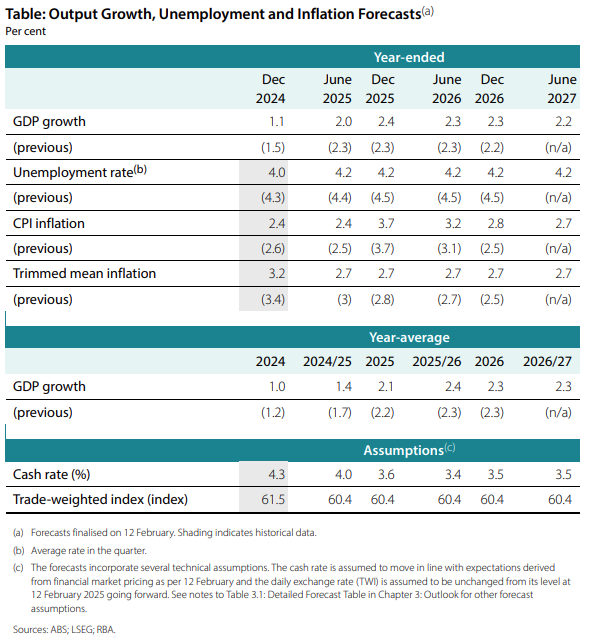
The downwards revisions to the RBA’s underlying inflation forecasts mean the RBA is now seeing it back in the target range a year earlier than expected in November.
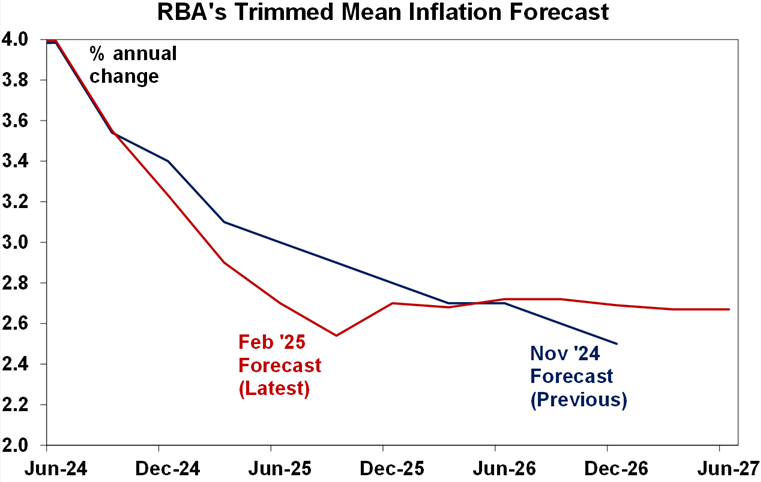
Source: RBA, AMP
In easing its worth noting that monetary policy is still tight with the 0.25% rate cut reversing just one of the 13 rate hikes between May 2022 and November 2023 which totalled 4.25%. For mortgage payments it will reverse about 8% (or $1300) of the $16,300 increase in annual payments on a $660,000 mortgage since May 2022. Consistent with this the RBA notes that monetary policy will still remain restrictive after the rate cut.
Having made the decision to cut the RBA is “cautious” on future cuts noting that while there are “risks on both sides”, on inflation “upside risks remain”, the labour market remains tight, productivity growth remains weak and that while it revised down its trimmed mean inflation forecasts for this year it revised them up slightly for next year. And it is concerned that if it eases too quickly, inflation could settle above the mid-point of the target. This is effectively a push back against market forecasts for further rate cuts that the RBA uses to drive its forecasts with the implication that in the RBA’s view the market is too optimistic on inflation and rates. So it doesn’t look like the RBA will be rushing into another rate cut just yet.
We think the RBA will hold at the April meeting, but cut again in May and then again in August
The RBA’s cautious guidance is understandable as it’s still too early for the RBA to declare “mission accomplished”. Given the lingering uncertainty about the strong jobs market and the low $A posing risks for inflation along with the uncertainty around Trump’s tariffs, in the absence of any major economic shock the RBA will likely leave rates on hold at its next meeting that concludes on 1 April. This will also enable it to avoid the political controversy of cutting rates in an election campaign or just before one has to be called and it will avoid perceptions that the Government stacked the new interest rate setting Board (that will take over from the next meeting) to drive an April cut and so minimise the RBA being politicised.
However, we continue to see further rate cuts ahead as we see economic growth picking up more slowly than the RBA is forecasting and slowing wages growth will cool sticky services inflation likely taking it to the mid-point of the target range next year.
- Sure unemployment is historically low at 4% but there is no sign of a wages breakout with wages growth actually slowing implying that the non-accelerating inflation rate of unemployment may actually be lower than the RBA’s assumed 4.5%. While the RBA acknowledges that this may be the case it notes that it does not yet see a “compelling case to change our assessment of full employment” or NAIRU.
- The $A fell sharply into January but has since had some recovery and the trade weighted index is in the same range it’s been in for four years, suggesting only modest upside pressure on inflation from the lower $A.
- Trump’s latest trade war adds to uncertainty but absent any retaliatory tariffs by Australia which is unlikely or a plunge in the $A, the tariffs pose more of a downside threat to Australian growth than an upside threat to inflation and so add to the case for cutting rates.
So, while the low unemployment rate means that the RBA can be gradual in easing, and we expect a pause in April, we expect two more rate cuts this year. One in May after the election is out of the way and then again in August, taking the case rate down to 3.6% with another rate cut next year.
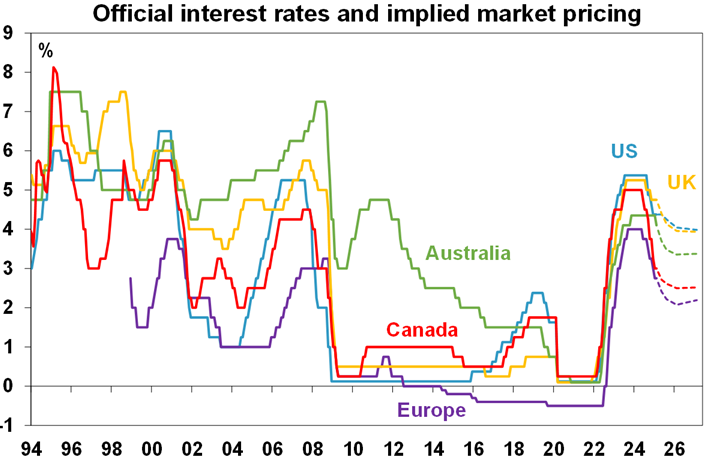
Source: Bloomberg, AMP
In support of further, albeit gradual, rate cuts underlying inflation in Australia is now in line with other countries which are cutting rates with the December monthly trimmed mean rate of 2.7%yoy similar to core inflation in Europe and Canada where cash rates have been cut below those in Australia.

Source: Bloomberg, AMP
Our Australian Pipeline Inflation Indicator points to a further fall in inflationary pressures ahead – and our Indicator does not take account of government “cost of living” relief, being more a guide to underlying pressures!
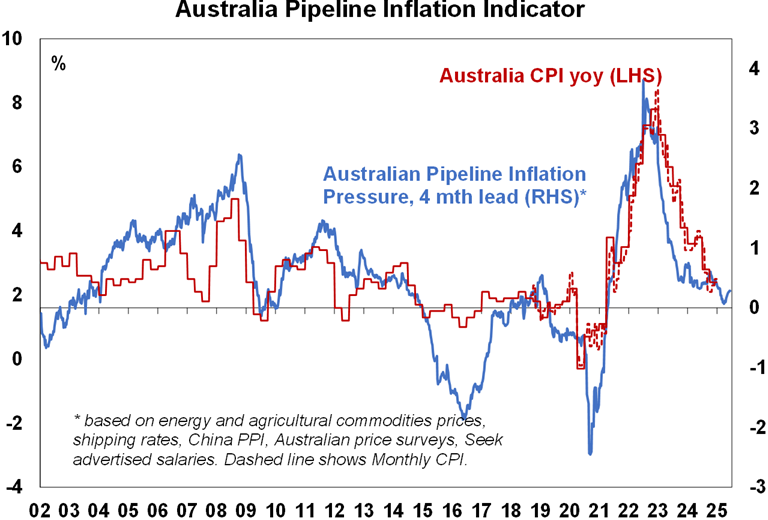
Source: Bloomberg, AMP
Expect a modest boost to economic growth
Banks are reportedly passing the 0.25% rate cut in full to their customers and we expect the start of an RBA rate cutting cycle to support a modest uptick in Australian economic growth this year to around 2%yoy, ie slightly below RBA forecasts. In particular, the 0.25% rate reduction will cut $108 off monthly mortgage payments on a $660,000 mortgage freeing up some spending power. In fact, the combination of the mortgage rate cut, last year’s July tax cuts and wages growth running above inflation will provide nearly an $80 a week boost to someone on average earnings with a mortgage compared to a year ago. See the next chart.
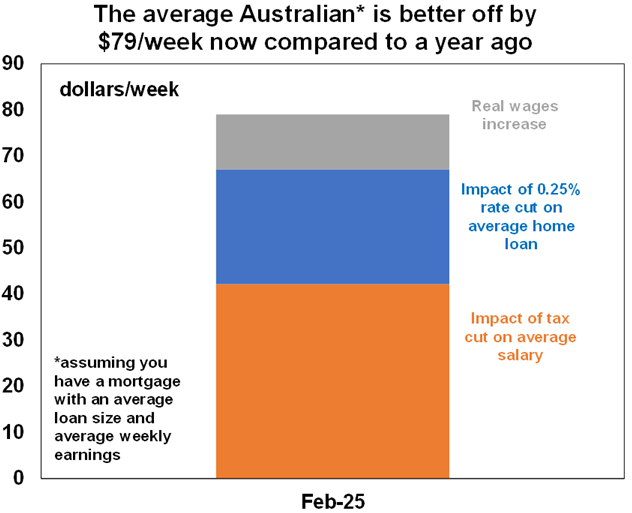
Source: ABS, AMP
However, the impact on spending is likely to be modest initially as: it takes a while for interest rate moves to start impacting spending as we saw with the initial hikes in 2022; rate cuts this year are expected to reverse only 3 of the 13 hikes (or 0.75% of the 4.25% rise); and rate cuts will be gradual particularly compared to the rapid fire rate hikes back in 2022 which may dampen expectations.
Rate cuts and Australian shares
RBA rate cuts can be positive for Australian shares because they help boost future profit growth and make shares relatively more attractive relative to cash. The next table shows the Australian share market’s response after the first rate cut at the start of an easing cycle.
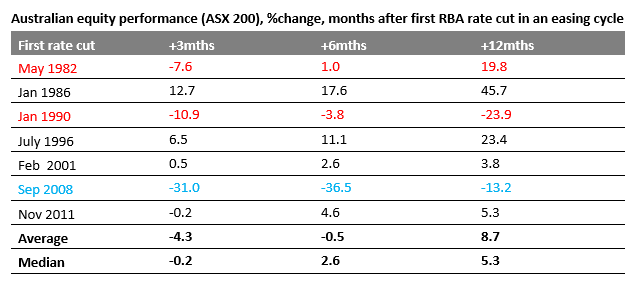
Recessions for the Australian economy are highlighted in red. The GFC is highlighted in blue. Source: Bloomberg, AMP
Clearly the experience is mixed, with recessions in 1982 and 1990 seeing falling share markets at least initially and the GFC and associated US recession impacting the outcome after the first easing in 2008, which drags down the average. Fortunately, a recession is unlikely, suggesting a better outcome is possible this time around. But shares have already had strong gains in anticipation of RBA rate cuts (helped along by rate cuts overseas), valuations are a bit stretched and Trump’s trade war and various other risks will no doubt make for a volatile ride. However, the start of rate cuts in the absence of recession still point to reasonable gains on a 12-month view.
What about the $A?
The start of a rate cutting cycle in Australia along with the RBA likely to cut more this year than the Fed will be a drag on the Australian dollar against the US dollar. However, the $A has already had an 11% fall against the $US since September to its recent low partly anticipating this along with Trump’s tariff war. So we see the $A being range bound between $US0.60 to $US0.70.
What about residential property?
Lower rates are positive for property because they take pressure off existing homeowners who may have been struggling with their mortgages leading to less listings and as they increase the amount a borrower can borrow from a bank and hence pay for a property which supports demand. Buyers know this and so can sometimes move to anticipate it as we have seen recently with stronger auction clearance rates in Sydney and Melbourne since late last year. Roughly speaking the 0.25% rate cut when passed on to variable mortgage rates will add about $9000 to how much a buyer on average earnings can borrow which along with three further rate cuts into early next year will drive a significant increase in the capacity of buyers to pay for a property. See the next chart which also allows for wages growth over the year ahead.
However, with housing affordability remaining poor, the capacity to pay set to remain well below the 2021-22 high with a wide gap to home prices and rate cuts likely to be gradual we are only anticipating a 3% rise in average home prices this year.
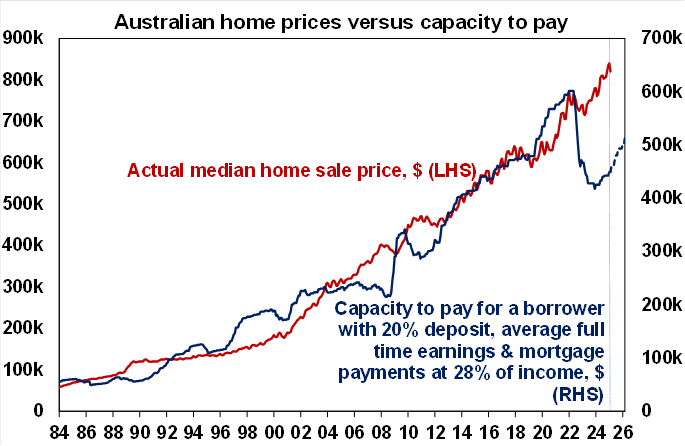
Source: RBA, CoreLogic, ABS, AMP
Ends
Important note: While every care has been taken in the preparation of this document, neither National Mutual Funds Management Ltd (ABN 32 006 787 720, AFSL 234652) (NMFM), AMP Limited ABN 49 079 354 519 nor any other member of the AMP Group (AMP) makes any representations or warranties as to the accuracy or completeness of any statement in it including, without limitation, any forecasts. Past performance is not a reliable indicator of future performance. This document has been prepared for the purpose of providing general information, without taking account of any particular investor’s objectives, financial situation or needs. An investor should, before making any investment decisions, consider the appropriateness of the information in this document, and seek professional advice, having regard to the investor’s objectives, financial situation and needs. This document is solely for the use of the party to whom it is provided. This document is not intended for distribution or use in any jurisdiction where it would be contrary to applicable laws, regulations or directives and does not constitute a recommendation, offer, solicitation or invitation to invest.





